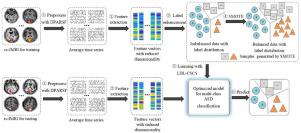Medical Image Analysis ( IF 10.7 ) Pub Date : 2021-10-31 , DOI: 10.1016/j.media.2021.102294 Jun Wang 1 , Fengyexin Zhang 2 , Xiuyi Jia 3 , Xin Wang 1 , Han Zhang 4 , Shihui Ying 5 , Qian Wang 4 , Jun Shi 1 , Dinggang Shen 6

|
The behavioral and cognitive deficits in autism spectrum disorder (ASD) patients are associated with abnormal brain function. The resting-state functional magnetic resonance imaging (rs-fMRI) is an effective non-invasive tool for revealing the brain dysfunction for ASD patients. However, most rs-fMRI based ASD diagnosis methods are developed for simple binary classification, instead of classification of multiple sub-types in ASD. Besides, they assume that the class boundary in ASD classification is crisp, whereas the symptoms of ASD sub-types are a continuum from mild to severe impairments in both social communication and restrictive repetitive behaviors/interests, and do not have crisp boundary between each other. To this end, we introduce label distribution learning (LDL) into multi-class ASD classification and propose LDL-CSCS under the LDL framework. Specifically, the label distribution is introduced to describe how individual disease labels correlate with the subject. In the learning crierion of LDL-CSCS, the label distribution is decomposed into the class-shared and class-specific components, in which the class-shared component records the common knowledge across all persons and the class-specific component records the specific information in each ASD sub-type. Low-rank constraint is imposed on the class-shared component whereas the group sparse constraint is imposed on the class-specific component, respectively. An Augmented Lagrange Method (ALM) is developed to find the optimal solution. The experimental results show that the proposed method for ASD diagnosis has superior classification performance, compared with some existing algorithms.
中文翻译:

基于类共享和类特定分解的标签分布学习的多类 ASD 分类
自闭症谱系障碍 (ASD) 患者的行为和认知缺陷与脑功能异常有关。静息态功能磁共振成像 (rs-fMRI) 是一种有效的非侵入性工具,用于揭示 ASD 患者的脑功能障碍。然而,大多数基于 rs-fMRI 的 ASD 诊断方法都是为简单的二元分类而开发的,而不是对 ASD 中的多个亚型进行分类。此外,他们假设 ASD 分类中的类别边界是清晰的,而 ASD 亚型的症状是从轻微到严重的社会交流障碍和限制性重复行为/兴趣的连续体,彼此之间没有清晰的边界。 . 为此,我们将标签分布学习(LDL)引入多类 ASD 分类,并在 LDL 框架下提出 LDL-CSCS。具体来说,引入标签分布来描述个体疾病标签如何与受试者相关。在 LDL-CSCS 的学习准则中,标签分布被分解为类共享组件和类特定组件,其中类共享组件记录所有人的共同知识,类特定组件记录特定信息每个 ASD 子类型。低秩约束施加在类共享组件上,而组稀疏约束分别施加在类特定组件上。开发了一种增广拉格朗日方法 (ALM) 来寻找最优解。











































 京公网安备 11010802027423号
京公网安备 11010802027423号